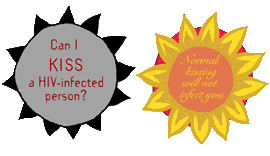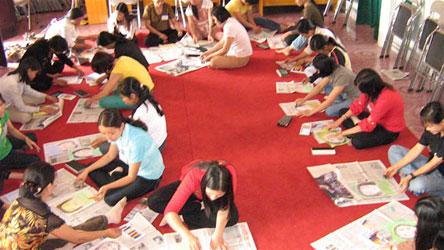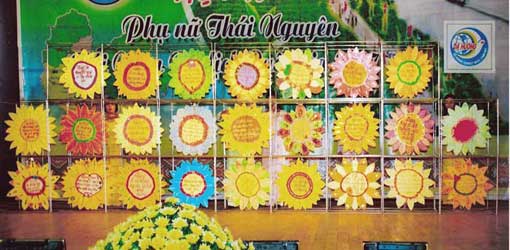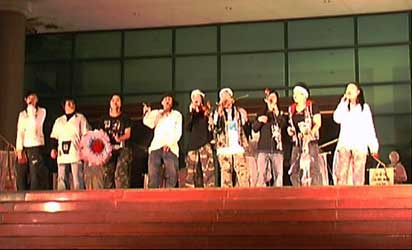WHO CARES?!
Art and therapy with HIV-infected women by Iris Honderdos and Arno Peeters
Vietnam
2006 and 2007
We were invited by the MCNV (Medical Comity Netherlands-Vietnam) to work with HIV-infected women. First in Thái Nguyên and Hanoi in 2006 and the next year in Cao Bang.
The project consists of three days of ‘Creative Communication Training’ a form of art therapy to loosen the group, allow for an intimate atmosphere and to bring out subjects that are difficult to discuss. The training was followed by the realization of an artwork, together with the same group.
Thái Nguyên
We started working in the northern city of Thái Nguyên and were given a space to work in by the Women’s Union. The group of women was already set up earlier as an initiative by the MCNV and is called the Sunflower Group, a self-help group consisting of at least 80 women of whom around 20 could take part in the project, together with some officials and staff of both the MCNV, the Red Cross and the Women’s Union. Altogether we had a group of 30 women to work with. The three-day communication training consisted of a delicate and deliberate balance of exercises and ‘fun’ on the one hand and discussion and reflection on the other.
One big advantage of being an artist in the first place (and a human communication expert in the second) is that it allows for a greater freedom and flexibility during the course of the project. So we had a lot of discussion and were monitoring closely what happened to the group, how they reacted to the exercises and what it’s effect was on both the group and the individual members; the goal in the end is to give the participants not only a temporary relief of the pain from their situation, but possibly also to hand them tools with which they can sustain their psychological health. A key factor is that they bond as a group and experience the power of working, laughing and talking together and explore each member’s individual strength. The exercises and games helped enormously to achieve that and after the training, the group was ready to endeavor into new grounds: the creation and performance of a work of art.
During the course of the training, we discovered that especially the discrimination by society, relatives and even family was a major problem to the women, so we decided that the performance should address this issue and the need for it to change.
In the meantime, the Women’s Union had found a perfect opportunity for a public performance: the annual tourist convention that would take place in the local art academy.
So while Arno concentrated on producing both a group song (composed by a local composer) and a soundtrack to fit the performance, Iris had to think of an artwork that could both involve the women in the actual creation of it and that would be effective on stage for an audience.
The Artwork
The solution we found was simple and effective: the installation consisted of 25 metal cubes with double sided sunflowers suspended in them: on the grey backsides were questions about HIV/Aids, mostly related to general misconceptions about how it can be transmitted. The answers were on the ‘sunny-sides’ of the flowers.
The soundtrack was guiding the performance which in a way looked like a game show in which each question asked by a presenter was in turn answered by the individual women themselves, both vocally in the composition but also by turning the flower around with the answer facing the audience.
It’s is a simple idea, but very effective in that it confronted the audience with general misconceptions in which the women were no longer ‘dangerous’ or ‘victims’, but the best educators one can think of.
The performance (still officially part of the tourist event) was a great success: initially the women were rightfully reluctant to appear on stage with media and audience present, but they themselves decided that nothing would change if they would be afraid to show themselves. We were proud to notice how they had evolved from victimized and dim women into brave performers.
Hánoi
The second project we did with the Sunflower-group in Hánoi. Here the theme was more complex: it’s a natural habit for women to be willing to sacrifice everything for the life or wellbeing of their children. In the case of HIV/AIDS, this can have a crucial impact: if the financial situation is out of balance or if food or medication fails short, a mother will want sacrifice her own health in favor of her child. The more favorable situation is that of healthy mother that can take care of her child and raise it herself: children that end up in orphanages or are being raised by relatives can lack a natural strength in understanding the world around them, sometimes setting them out to drift into criminal behavior, drug abuse or depression.
So these mothers need all kinds of support in raising their child: from the family, the government, the society.
The Artwork
The installation showed the life-size figures of the women, covered with cloth. On it, the women wrote a short letter to their child, expressing their endless love for him or her. On the ground next to the figures is a quang gánh; a double shoulder basket which is very typical for poor people to carry their goods (or sometimes even their children) in.
| |
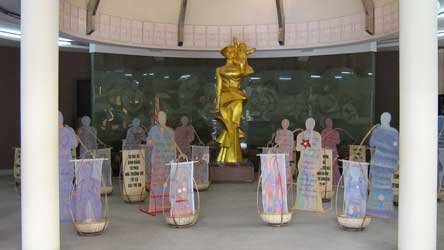 |
|
In the front basket, there’s a child created from cloth, in the rear basket a scroll with a mission printed on it, underlining the support HIV infected mothers need in order to raise their child (proper jobs, equal access to medical treatment etc.).
Again guided by a soundtrack, the women one by one would read their love letter to the audience and then, appearing from behind their own figure, would stand in front of it, to raise their quang gánh and thereby slowly raising both the cloth representation of their child together with the support they need to ‘raise’ their child.
 |
Cactus Blossoms in The Sand
Coincidence or not: the negative result of growing up in unusual circumstances also surfaced with another group of women that especially Arno worked with, the Cactus Blossoms. This is another self-help group initiated by the MCNV, but consisting of ex drug users infected by HIV. |
They have to deal with probably the fiercest stigmas in Vietnamese society; they are at the rock bottom of the social ladder and therefore are used to see themselves as losers without any useful purpose in society.
After again three days of very intensive communication training, they had learned to take a different view on themselves and their life stories: that they were deprived of vital elements during their upbringing or had suffered loss, sorrow and heartache. Factors that play an important role in their move to drug abuse. Arno introduced them to rap, originally an Afro-American musical tradition of rhythmical storytelling with the purpose to warn or educate, sometimes even to provoke.
Together with the help of Vietnamese rapper Kim Jo-Jo, they turned their life stories into lyrics, aimed at the Vietnamese youth to warn them about real life situations that may entice to use drugs.
The rap ‘Cactus Blossoms in The Sand’ would be performed on the same evening the Sunflowers would present their work at the National Women’s Museum.
“Who Cares?!”
The performance was named “Who Cares?!” and we were fortunate to have the Sunflower-group from Thái Nguyên to perform their Sunflower-show again in Hánoi, so together with the Cactus Blossoms, we would have a full and ‘attractive’ program: attractive to a greater audience and the media, both equally important to spread the message.
“Who Cares?!” was a great success; at least 500 people showed up to see the open-air performance and the media were present in large numbers, including National Television.
Conclusion
The Sunflowers were touching each and everyone in the human sense, not in the medical sense and both installations are on display in the museum for every one to see.
The Cactus Blossom-crew was presented as a rap group with a real story to tell and finally the media coverage of the event helped to target a large audience at once. Also a video clip has been made by Iris of their song and as a DVD; it will eventually accompany the edition of a youth magazine and could be screened on TV. Unfortunately familymembers of some of the CactusBlossom-members have opposed this, as they're afraid of possible discrimination of their children. The clip will be shown in group-presentations only. Therefore it's also not possible to show it online, on YouTube for instance. It's such a pity, but a decision we have to respect.
Projects >>
|
